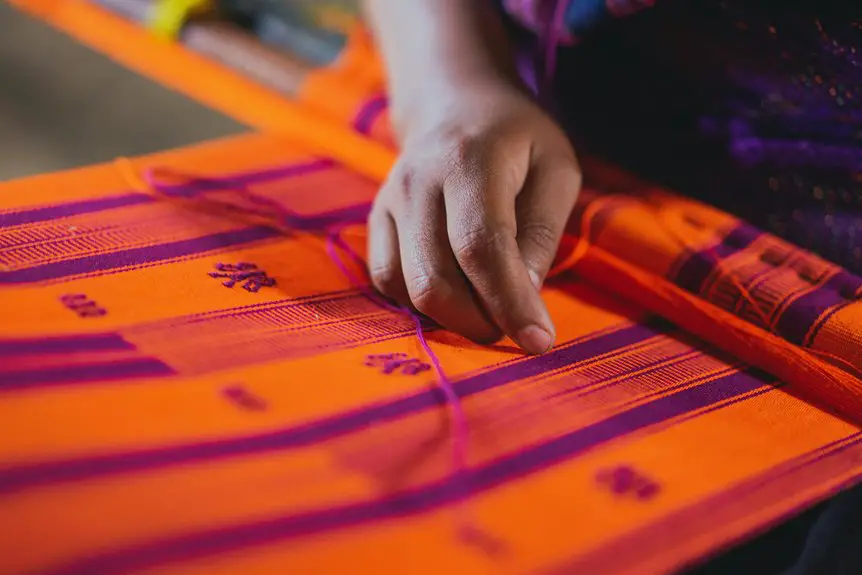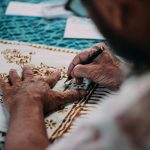When cutting patterns from corduroy, start by pre-washing and ironing gently on the wrong side to preserve the pile. Use sharp fabric scissors or a rotary cutter to get clean edges, and pin your patterns securely to prevent shifting. Align pattern pieces so the nap runs the same way for consistent texture. Cut slowly and carefully to avoid crushing the ridges. Follow these steps closely, and you’ll find even more tips to make your project successful.
Table of Contents
Key Takeaways
- Pre-wash corduroy to remove sizing and prevent shrinkage before cutting patterns.
- Align pattern grainline parallel to the selvage and check pile direction for consistent texture.
- Use sharp fabric scissors or rotary cutters and cut slowly to avoid crushing the pile.
- Pin patterns securely perpendicular to the grainline to prevent fabric shifting and distortion.
- Cut on a flat, stable surface with a non-slip mat, handling one layer at a time for accuracy.
Understanding Corduroy Fabric and Its Characteristics
Corduroy’s distinctive ribbed texture sets it apart from other fabrics, making it both durable and comfortable. When you work with corduroy, you’ll notice its raised “wales”—those vertical ridges—that vary in width. The wale count affects the fabric’s look and feel; fewer wales mean wider ridges, while more wales create a finer texture.
Corduroy is usually made from cotton or cotton blends, giving it a soft yet sturdy structure. It has a slight stretch, but not much, so you’ll want to handle it gently to avoid distortion.
Because of its pile, corduroy can show light differently depending on how you lay it, so you need to be mindful of direction when cutting. Understanding these traits helps you achieve a neat, professional finish.
Preparing Corduroy for Cutting
Before you start cutting, take time to prepare your corduroy properly to guarantee clean, accurate pieces. Begin by pre-washing to remove sizing and prevent shrinkage later. Iron your fabric gently on the wrong side to avoid crushing the pile. Lay it flat on a large surface, smoothing out any wrinkles or folds.
Visualize the process:
| Preparation Step | What to Do |
|---|---|
| Pre-wash | Remove chemicals, prevent shrink |
| Ironing | Use low heat, protect pile |
| Laying Flat | Smooth wrinkles, align edges |
| Nap Direction | Check and mark fabric pile |
| Pinning Pattern | Secure carefully without distortion |
Choosing the Right Tools for Cutting Corduroy
When cutting corduroy, picking the right scissors can make all the difference in clean, precise edges.
You’ll also want to contemplate a rotary cutter for smooth, straight lines without snagging the fabric.
Don’t forget an essential cutting mat to protect your workspace and keep your tools sharp.
Best Scissors Types
Choosing the right scissors can make all the difference in cutting corduroy smoothly and accurately. You’ll want sharp fabric scissors designed specifically for textiles, as they glide through the thick ridges without snagging.
Avoid dull or general-purpose scissors, which can crush the pile and cause uneven cuts. Bent-handled scissors help keep your hand above the fabric, giving you better control and preventing accidental snips into the material.
For detailed pattern work, small embroidery scissors work well for precision trimming around curves and corners. Keep your scissors clean and sharpened regularly to maintain smooth cuts.
Rotary Cutter Benefits
Sharp scissors make cutting corduroy easier, but a rotary cutter can take your cutting precision to the next level. When you use a rotary cutter, you’ll find it glides smoothly through the thick ridges of corduroy without snagging or pulling the fabric.
This tool offers cleaner, straighter edges that scissors sometimes struggle to achieve, especially on dense fabrics like corduroy. Plus, it speeds up your cutting process, saving you time and effort.
Here’s why a rotary cutter benefits your corduroy projects:
- Provides consistent, precise cuts for intricate pattern details
- Minimizes fabric distortion by applying even pressure
- Reduces hand fatigue during long cutting sessions
Using a rotary cutter will boost your accuracy and efficiency, making your sewing projects look professionally finished.
Essential Cutting Mats
Since cutting corduroy requires precision and care, using the right cutting mat can make a huge difference in your results.
Choose a self-healing cutting mat that’s large enough to accommodate your fabric and pattern pieces comfortably. This type of mat protects your blades and surfaces, allowing you to make smooth, accurate cuts.
Look for mats with grid lines and angle markings; these guides help you align your fabric and patterns perfectly. A sturdy mat also prevents slipping, which is vital when working with corduroy’s textured surface.
Avoid mats that are too thin or worn out, as they can cause uneven cuts and damage your rotary cutter. Investing in a quality cutting mat guarantees clean edges and saves time during your sewing projects.
Laying Out Patterns on Corduroy Fabric
When you lay out patterns on corduroy fabric, aligning the nap direction is essential to guarantee a consistent appearance and texture.
Before pinning your pattern pieces, smooth the fabric on a flat surface to avoid wrinkles or shifting. Pay close attention to the grainline markings on your patterns, ensuring they run parallel to the selvage. This helps maintain the fabric’s structure and drape. Remember to factor in the fabric’s stretch or give, especially if your corduroy has stretch fibers.
Smooth fabric flat and align grainline parallel to selvage, considering stretch for proper structure and drape.
Keep these tips in mind:
- Lay out all pattern pieces before cutting to visualize fabric usage.
- Use weights or pins carefully to prevent shifting without damaging the pile.
- Double-check placement to avoid cutting pieces upside down or misaligned.
Proper layout sets a strong foundation for precise cutting.
Aligning Pattern Pieces With Corduroy’S Nap
Before you cut, make certain you identify the direction of the corduroy’s nap by running your hand over the fabric.
Always place your pattern pieces so they align with the nap’s direction to guarantee a consistent look and feel.
This step helps prevent color shading differences and keeps your garment looking polished.
Identifying Corduroy Nap Direction
Although corduroy’s texture adds warmth and style, its nap direction demands careful attention when cutting patterns. You need to identify the nap to guarantee all pieces align correctly, preventing color shifts and texture inconsistencies in your finished garment.
To identify the nap direction, run your hand gently over the fabric surface.
- When you move your hand downward, the nap should feel smooth and soft; moving upwards will feel rougher.
- Hold the fabric at an angle to see how light reflects—nap direction causes subtle shading differences.
- Check for pile orientation by examining the tiny ridges (wales); they all lean the same way.
Once you identify the nap, mark it clearly on your fabric before placing pattern pieces.
Pattern Placement Strategies
Since corduroy’s nap affects both appearance and texture, you’ll need to position your pattern pieces carefully to guarantee all parts of your garment align consistently.
Always lay your fabric nap-side down and align all pattern pieces in the same direction, following the nap. This ensures uniform color and sheen across your garment. Avoid flipping pieces upside down, even if it means adjusting layout efficiency.
Use weights or pins to secure pieces and prevent shifting. When cutting double layers, pin them carefully to keep the nap direction consistent on both layers.
Mark nap direction on your pattern pieces to avoid confusion during cutting and sewing. By respecting corduroy’s nap in your pattern placement, you’ll achieve a polished, professional finish with consistent texture and color throughout.
Techniques to Prevent Fabric Shifting
When cutting corduroy, you’ll want to keep the fabric from shifting to guarantee your patterns stay accurate. Corduroy’s texture can make it prone to sliding, which messes with your measurements. To prevent this, you’ll need some reliable techniques.
- Use sharp fabric scissors or a rotary cutter to cut cleanly without tugging the fabric.
- Pin generously along the edges and inside the pattern pieces to secure the fabric layers together.
- Place a non-slip mat or a sheet of tissue paper under the fabric to add grip and prevent sliding on your cutting surface.
Cutting Corduroy Without Distorting the Pile
If you want your corduroy projects to look professional, you’ll need to cut the fabric without crushing or distorting its distinctive pile. Start by laying the fabric flat on a hard surface and smooth it gently with your hands to lift the pile.
Avoid pressing down hard, as this flattens the ribs. Use sharp scissors or a rotary cutter to guarantee clean edges without pulling on the fabric.
When pinning your pattern, place pins perpendicular to the grain, and avoid sliding the fabric too much to keep the pile intact. Cut slowly and carefully, following the pattern lines without forcing the blade.
Taking these steps helps maintain the texture and appearance of corduroy, guaranteeing your finished pieces look crisp and professional.
Handling Seams and Edges on Corduroy
Three key techniques will help you handle seams and edges on corduroy without damaging its pile. First, always sew with the nap direction in mind to keep the fabric’s texture consistent.
Next, press seams carefully using a low heat setting and a pressing cloth to avoid crushing the pile. Finally, finish raw edges with a serger or zigzag stitch to prevent fraying while maintaining flexibility.
- Use clips instead of pins to avoid marking the fabric.
- Trim seam allowances slightly to reduce bulk, but don’t cut too close to the stitch line.
- When topstitching, use longer stitches to prevent perforating the fabric and weakening the seam.
Tips for Storing and Managing Leftover Corduroy Pieces
A well-organized storage system can make managing leftover corduroy pieces much easier and prevent damage to the fabric. You’ll want to sort pieces by size and color, then store them flat or rolled to avoid creases. Use breathable containers to keep fabric fresh and avoid moisture buildup. Label each container clearly, so you find what you need quickly. Here’s a simple way to think about leftover storage:
| Emotion | Storage Tip |
|---|---|
| Relief | Clear labels for quick access |
| Pride | Neatly folded or rolled pieces |
| Satisfaction | Breathable containers protect |
Frequently Asked Questions
Can Corduroy Be Machine Washed Without Damaging the Fabric Pile?
Before washing corduroy, think like a Victorian laundress: you shouldn’t machine wash it carelessly. You can, but use cold water, gentle cycle, and turn it inside out to protect the pile from damage and keep it soft.
What Types of Garments Are Best Suited for Corduroy Fabric?
You’ll find corduroy works great for jackets, pants, skirts, and casual dresses. Its durability and texture add warmth and style, making it perfect for fall and winter wardrobe staples you’ll love wearing.
How Do You Repair Snags or Pulls in Corduroy Fabric?
You can fix snags in corduroy by gently pulling the fabric around the snag to realign the fibers, then using a needle to tuck loose threads back. Avoid cutting to prevent worsening the damage.
Is It Possible to Dye Corduroy Fabric at Home?
Yes, you can dye corduroy at home, but you’ll need fabric dye suitable for cotton or blends. Pre-wash the fabric, follow dye instructions carefully, and remember corduroy’s texture might affect even color absorption.
What Is the Best Way to Iron Corduroy Without Crushing the Pile?
You should iron corduroy inside out on a low heat setting, using a pressing cloth to protect the pile. Avoid pressing too hard or using steam directly to prevent crushing the fabric’s texture and ridges.
- Does Chiffon Fabric Stink - July 15, 2025
- Does Chiffon Fabric Affect the Economy - July 15, 2025
- Does Cotton Fabric Have a Nap - July 15, 2025




